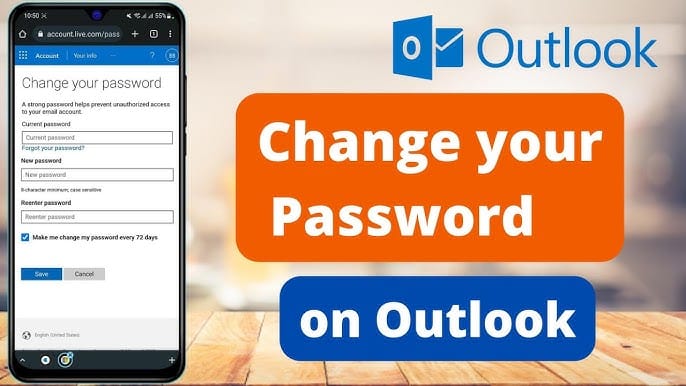Maintaining strong passwords is crucial for safeguarding your online accounts, including your Outlook email. Regularly changing your Outlook password helps prevent unauthorized access and protect your sensitive information.
This guide will outline the steps involved in changing your Outlook password and provide additional security-enhancing measures to bolster your email protection.
Why should you change your Outlook password?
Changing your Outlook password is essential for several reasons:
Prevents unauthorized access: Changing your password regularly reduces the likelihood of your account being compromised by malicious actors who may have obtained your old credentials.
Protects against data breaches: If your password is exposed due to a data breach at another site, changing it immediately minimizes the risk of your Outlook account being accessed.
Enhances overall security: Regularly updating your password is part of a comprehensive cybersecurity strategy that helps safeguard your online presence.
Related Post: Where is the Largest Home Depot in the US?
When should you change your Outlook password?
There are several scenarios that warrant changing your Outlook password:
After a data breach: If you learn that your password may have been exposed in a data breach at any website or service, change it immediately, even if you have not received a direct notification from Outlook.
Suspicion of unauthorized access: If you notice any suspicious activity in your Outlook account, such as unfamiliar login attempts or changes to your settings, change your password immediately to regain control.
Sharing your password: If you have shared your Outlook password with someone and want to revoke their access, change your password to prevent further use.
Regularly for security: Even if there is no specific reason to suspect a compromised password, it is advisable to change your Outlook password regularly as a preventive measure. A good practice is to change your password every 3-6 months.
How to Change Password
There are three main ways to change your password in Outlook: through Outlook.com, through the Outlook desktop app, or through the Outlook mobile app. The specific steps will vary depending on which method you use, but the general process is the same.
Related Post: Royal Ages: Uncovering How Old Prince Harry Is Today
How to Change Password in Outlook.com
- Go to the Microsoft account security page.
- Sign in with your current password if asked to.
- Click the Change my password option under Password security.
- Enter your new password. Make sure the password is at least 8 characters long and includes a mix of upper and lowercase letters, numbers, and symbols.
- Click Save.
How to Change Password in Outlook Client Desktop App: Window and MAC
Windows:
- Open Outlook.
- Click the File tab.
- Click Account Settings.
- Click Manage Profiles.
- Click Email Accounts.
- Select the account you want to change the password for.
- Click Change.
- Update your password and click Next.
- Confirm the change and close the Account Settings window.
Mac:
- Open Outlook for Mac.
- On the Tools tab, select Accounts.
- In the left pane, select the account you want to change the password for.
- Click the Advanced tab.
- Click the Passwords tab.
- Enter your new password.
- Click OK.
Related Post: How to Change Your iPhone Name: Personalization Proficiency
How to Change Password in Outlook Mobile App: Android and iPhone
Android:
- Open the Outlook mobile app.
- Tap the three lines in the top left corner.
- Scroll down and tap Settings.
- Tap the account you want to change the password for.
- Tap Account security.
- Tap Change password.
- Enter your current password.
- Enter your new password.
- Tap Change password.
iPhone:
- Open the Outlook mobile app.
- Tap the Settings gear in the bottom right corner.
- Tap Mail.
- Tap Accounts.
- Tap the account you want to change the password for.
- Tap Password.
- Enter your current password.
- Enter your new password.
- Tap Done.
Related Post: How Much is Tom Cruise Worth: Celebrity Wealth Curiosity
How to Reset a Forgotten Outlook Password
Go to the Outlook password reset page: Visit the Outlook account recovery page (https://account.live.com/Password/reset] and enter the email address associated with your Outlook account.
Verify your account: Microsoft will send a verification code to your registered phone number or recovery email address. Enter the code to confirm your identity.
Create a new password: Once your identity is verified, you’ll be prompted to create a new password. Choose a strong password that is unique to your Outlook account and avoid using easily guessable information like your name or birthday.
Sign in to your account: After creating a new password, you should be able to sign in to your Outlook account using your updated credentials.
What happens after I change my Outlook password?
Your old password is invalidated: Changing your Outlook password invalidates your old password, preventing anyone with unauthorized access from using it to sign in to your account.
Your account security is enhanced: Resetting your password helps to improve the security of your Outlook account by ensuring that only you have access to it.
You may need to re-enter your password in some apps: Some applications that connect to your Outlook account may require you to re-enter your password after resetting it.
Related Post: How to Draw Shoes: Unleashing Creativity in Fashion Illustration
What should I do if my Outlook account has been hacked?
Regain control of your account: Immediately follow Microsoft’s instructions to regain control of your Outlook account. This may involve resetting your password and removing any unauthorized access.
Scan your device for malware: Run a thorough scan of your device with a reputable antivirus program to eliminate any potential malware that may have compromised your account.
Change your passwords for other accounts: If you suspect that your Outlook password may have been used to access other accounts, change those passwords as well to prevent further unauthorized access.
Enable two-factor authentication: Two-factor authentication adds an extra layer of security to your Outlook account by requiring you to enter a verification code in addition to your password when signing in.
Be cautious of phishing emails: Phishing emails are designed to trick you into revealing personal information or clicking on malicious links. Be wary of emails that ask for your password or direct you to suspicious websites.
Report the incident to Microsoft: If you believe your Outlook account has been compromised, report the incident to Microsoft using their support channels. This helps Microsoft track and address security issues.
Additional security measures for email protection
Apart from changing your password, consider these additional steps to enhance your Outlook email security:
Enable two-factor authentication (2FA): 2FA adds an extra layer of protection by requiring a secondary verification method, such as a code from your phone or an authenticator app, in addition to your password.
Be cautious about links and attachments: Avoid clicking on links or opening attachments from unknown senders, as they may contain malware or phishing attempts.
Use a strong and unique password: Create a password that is complex, lengthy, and unique to your Outlook account. Avoid using personal information or easily guessable patterns.
Beware of phishing scams: Be vigilant about emails that attempt to trick you into revealing personal information or clicking on malicious links.
Regularly update Outlook software: Ensure you are running the latest version of Outlook to benefit from security updates and patches.
By following these guidelines and implementing additional security measures, you can significantly enhance your Outlook email protection and safeguard your sensitive information.
Related Post: How to Blur Background in Zoom: Video Call Enhancements
Conclusion
Your Outlook password is the same as your Microsoft account password. You can change your password from the Microsoft account website or from within the Outlook app.
FAQs
It is a good idea to change your Outlook password every three to six months. This will help to keep your account secure.
A strong password should be at least 8 characters long and include a mix of upper and lowercase letters, numbers, and symbols. You should avoid using personal information, such as your name or birthday, in your password.
If you forget your Outlook password, you can reset it by following the instructions on the Microsoft account password recovery page.
References
- clean.email/change-password-in-outlook
- androidpolice.com/microsoft-outlook-change-password/
- businessinsider.com/change-outlook-password
- process.st/change-password-on-microsoft-outlook/






